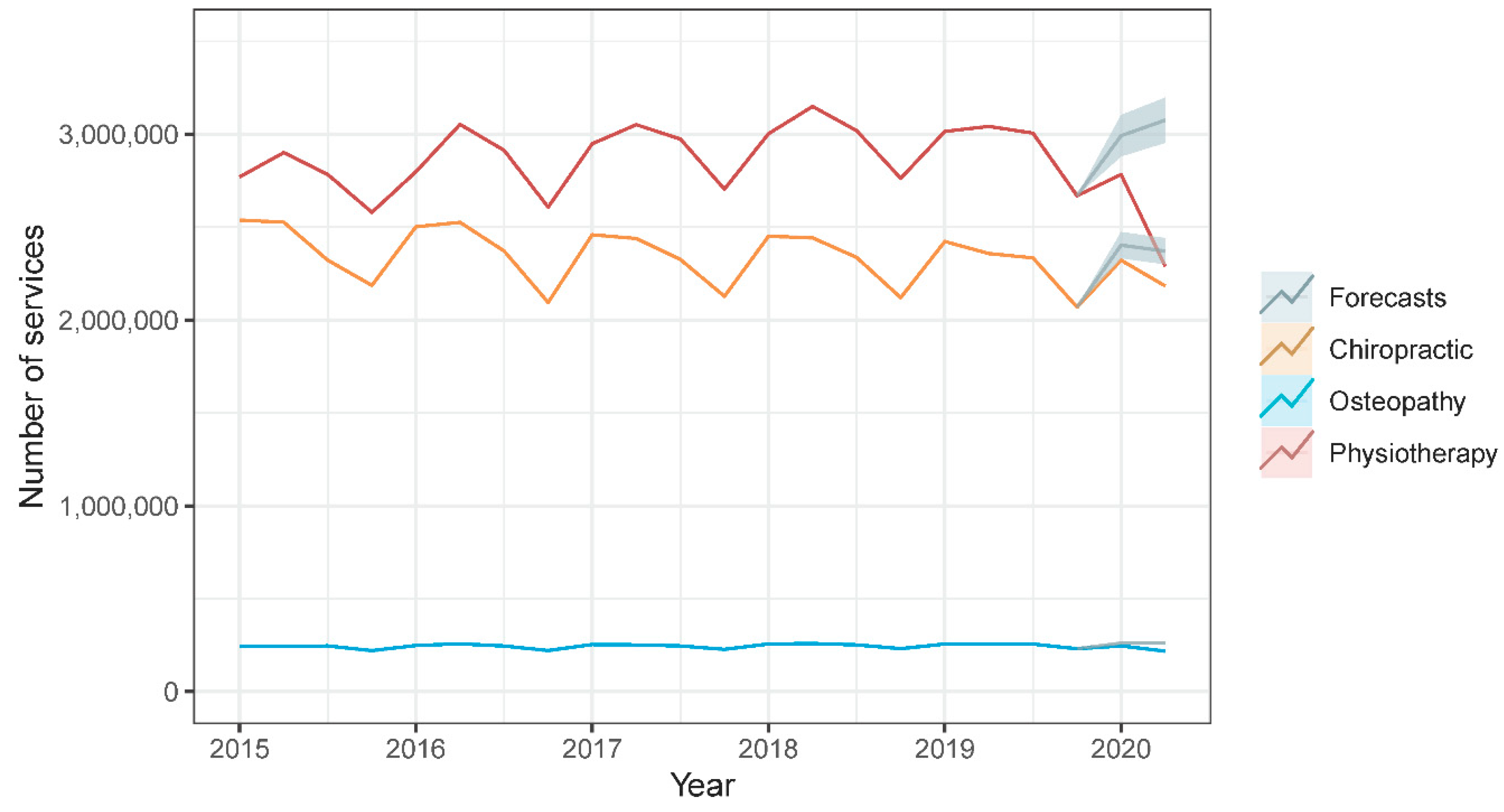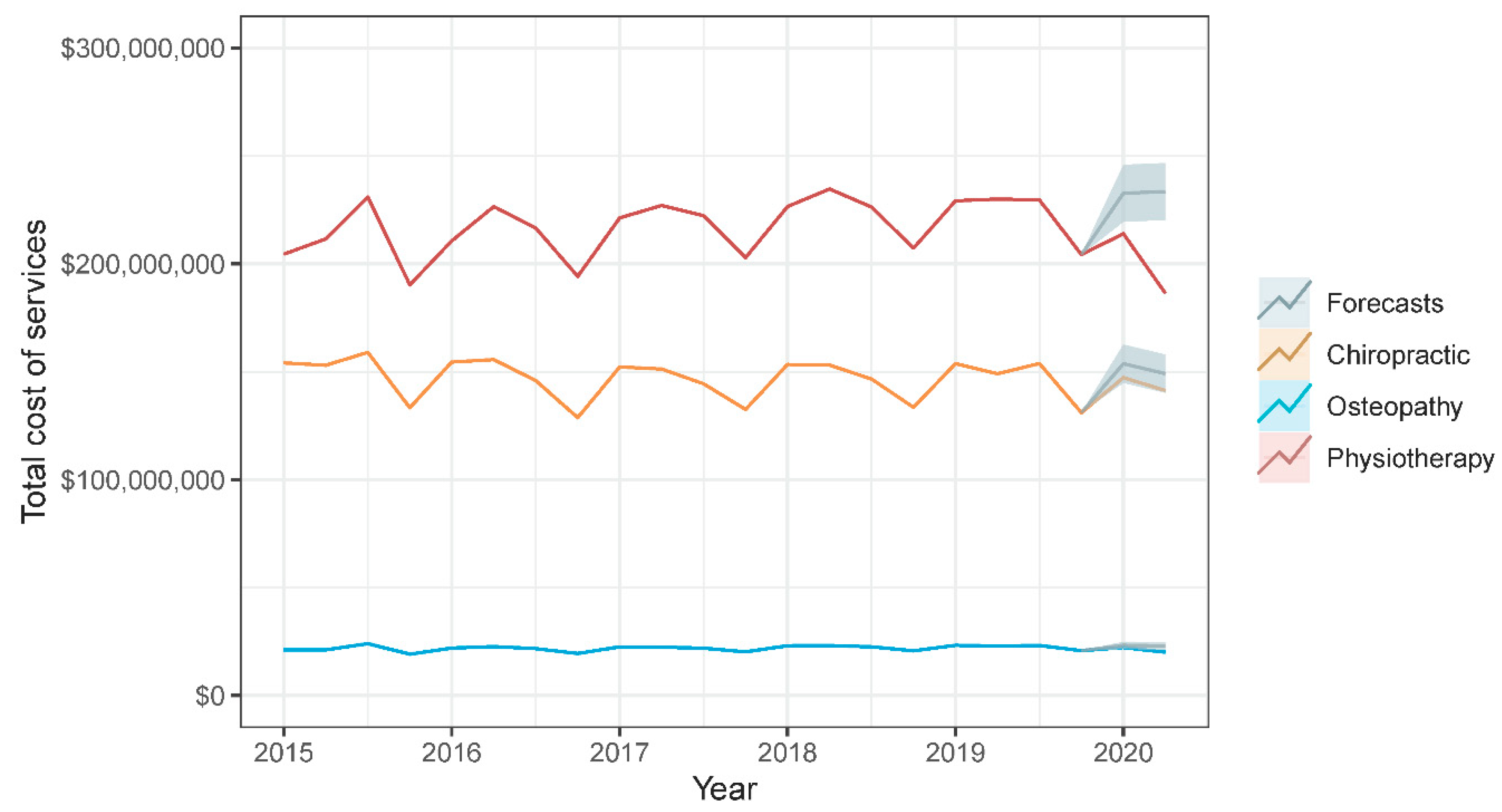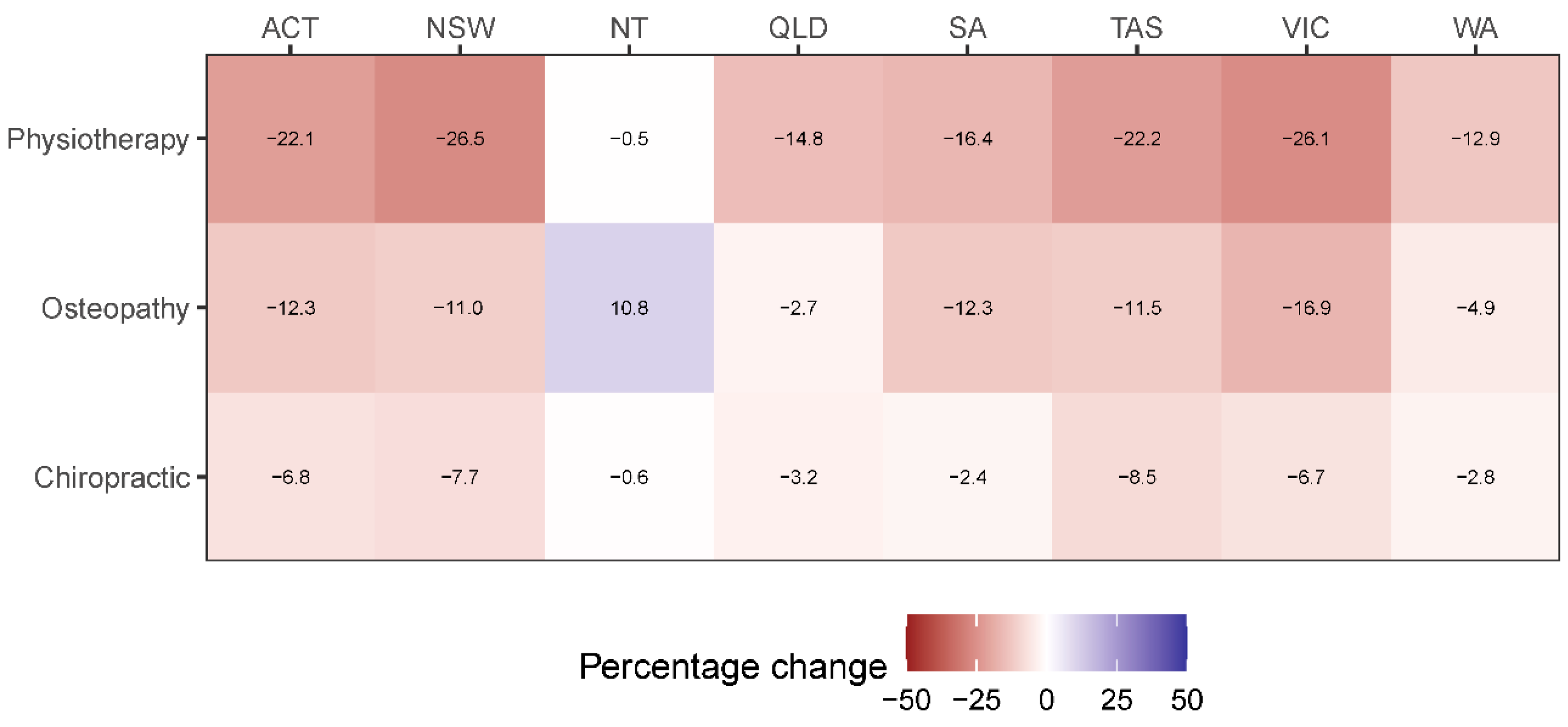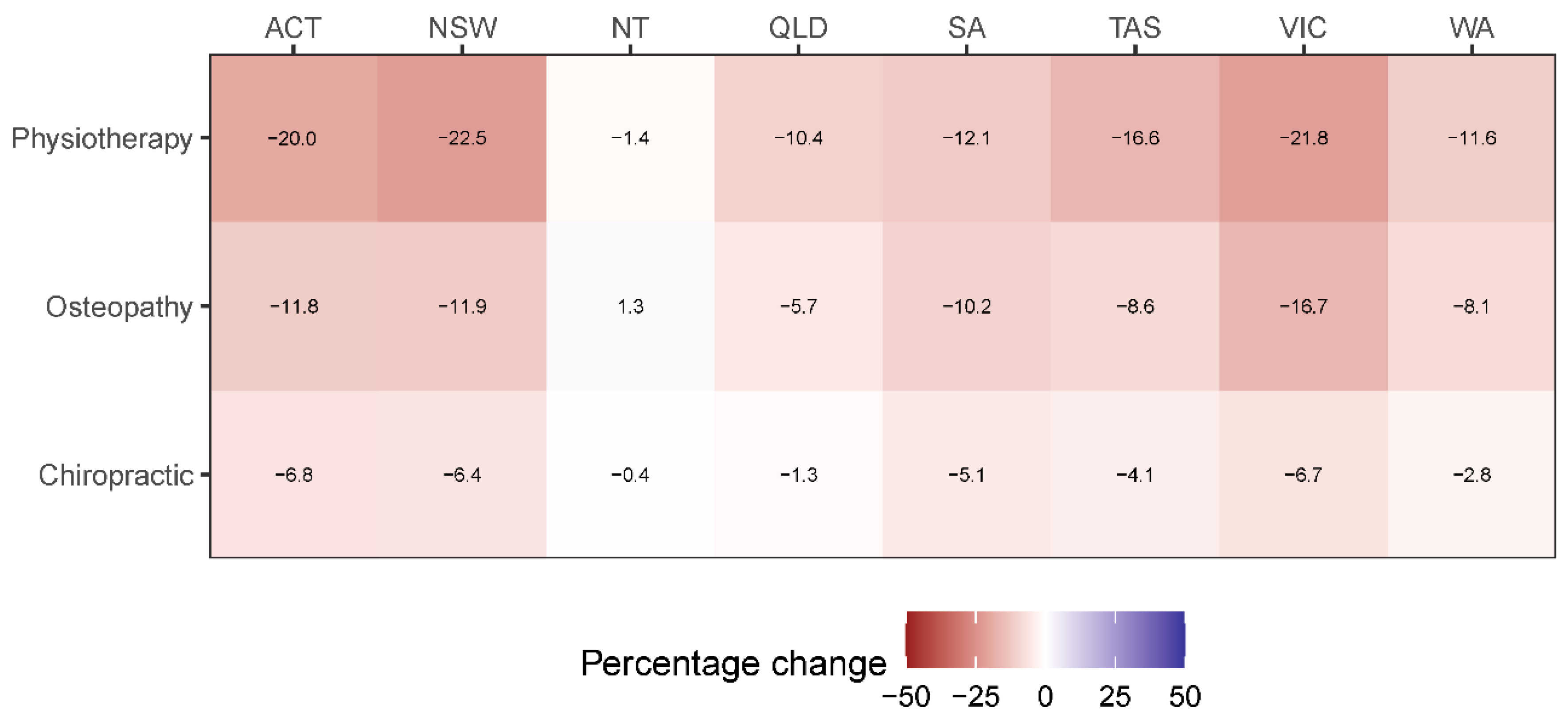Impact of the COVID-19 Pandemic on Manual Therapy Service Utilization within the Australian Private Healthcare Setting
Abstract
:1. Introduction
2. Materials and Methods
2.1. Data Sources
2.2. Operational Definitions
2.3. Data Management and Analysis
3. Results
4. Discussion
5. Conclusions
Supplementary Materials
Author Contributions
Funding
Conflicts of Interest
References
- World Health Organization. WHO Director-General’s Opening Remarks at the Media Briefing on COVID-19—11 March 2020. Available online: https://www.who.int/dg/speeches/detail/who-director-general-s-opening-remarks-at-the-media-briefing-on-covid-19---11-march-2020 (accessed on 23 July 2020).
- Desai, S.M.; Guyette, F.X.; Martin-Gill, C.; Jadhav, A.P. Collateral damage—Impact of a pandemic on stroke emergency services. J. Stroke Cerebrovasc. Dis. 2020, 29, 104988. [Google Scholar] [CrossRef] [PubMed]
- Kristoffersen, E.S.; Jahr, S.H.; Thommessen, B.; Rønning, O.M. Effect of COVID-19 pandemic on stroke admission rates in a Norwegian population. Acta Neurol. Scand. 2020, 142, 632–636. [Google Scholar] [CrossRef] [PubMed]
- Bersano, A.; Kraemer, M.; Touzé, E.; Weber, R.; Alamowitch, S.; Sibon, I.; Pantoni, L. Stroke care during the COVID-19 pandemic: Experience from three large European countries. Eur. J. Neurol. 2020, 27, 1794–1800. [Google Scholar] [CrossRef] [PubMed]
- Parikh, K.D.; Ramaiya, N.H.; Kikano, E.G.; Tirumani, S.H.; Pandya, H.; Stovicek, B.; Sunshine, J.L.; Plecha, D.M. COVID-19 Pandemic impact on decreased imaging utilization: A single institutional experience. Acad. Radiol. 2020, 27, 1204–1213. [Google Scholar] [CrossRef] [PubMed]
- Duszak, R.; Maze, J.; Sessa, C.; Fleishon, H.B.; Golding, L.P.; Nicola, G.N.; Hughes, D.R. Characteristics of coronavirus disease 2019 (COVID-19) community practice declines in noninvasive diagnostic imaging professional work. J. Am. Coll. Radiol. 2020, 17, 1453–1459. [Google Scholar] [CrossRef] [PubMed]
- Chou, Y.-C.; Yen, Y.-F.; Feng, R.-C.; Wu, M.-P.; Lee, Y.-L.; Chu, D.; Huang, S.-J.; Curtis, J.R.; Hu, H.-Y. Impact of the COVID-19 pandemic on the utilization of hospice care services: A cohort study in Taiwan. J. Pain Symptom Manag. 2020, 60, e1–e6. [Google Scholar] [CrossRef] [PubMed]
- Chiropractic Board of Australia. Statistics. Available online: https://www.chiropracticboard.gov.au/About-the-Board/Statistics.aspx (accessed on 23 July 2020).
- Osteopathy Board of Australia. Statistics. Available online: https://www.osteopathyboard.gov.au/About/Statistics.aspx (accessed on 23 July 2020).
- Physiotherapy Board of Australia. Statistics. Available online: http://www.physiotherapyboard.gov.au/about/statistics.aspx (accessed on 23 July 2020).
- Engel, R.M.; Brown, B.T.; Swain, M.S.; Lystad, R.P. The provision of chiropractic, physiotherapy and osteopathic services within the Australian private health-care system: A report of recent trends. Chiropr. Man. Therap. 2014, 22, 3. [Google Scholar] [CrossRef] [PubMed] [Green Version]
- Lystad, R.P.; Brown, B.T.; Swain, M.S.; Engel, R.M. Service utilisation trends in the manual therapy professions within the Australian private healthcare setting between 2008 and 2017. Chiropr. Man. Therap. 2020, 28, 49. [Google Scholar] [CrossRef] [PubMed]
- Australian Prudential Regulation Authority. Available online: https://www.apra.gov.au/ (accessed on 23 July 2020).
- Australian Health Practitioner Regulation Agency. Available online: https://www.ahpra.gov.au/ (accessed on 23 July 2020).
- Australian Institute of Health and Welfare. Allied Health Work Force 2012; Australian Institute of Health and Welfare: Canberra, Australia, 2013.
- Reserve Bank of Australia. Inflation Calculator. Available online: https://www.rba.gov.au/calculator/ (accessed on 14 October 2020).
- Hyndman, R.J.; Athanasopoulos, G. Forecasting: Principles and Practice, 3rd ed.; OTexts: Melbourne, Australia, 2018. [Google Scholar]
- World Health Organization. COVID-19 Significantly Impacts Health Services for Noncommunicable Diseases. Available online: https://www.who.int/news/item/01-06-2020-covid-19-significantly-impacts-health-services-for-noncommunicable-diseases (accessed on 6 November 2020).
- Cancer Australia. Review of the Impact of COVID-19 on Medical Services and Procedures in Australia Utilising MBS Data: Skin, Breast and Colorectal Cancers, and Telehealth Services; Cancer Australia: Sydney, Australia, 2020. [Google Scholar]
- Australian Institute of Health and Welfare. Cancer Screening and COVD-19 in Australia. Available online: https://www.aihw.gov.au/reports/cancer-screening/cancer-screening-and-covid-19-in-australia/contents/how-has-covid-19-affected-australias-cancer-screening-programs (accessed on 6 November 2020).
- Wong, F.L.; Antoniou, G.; Williams, N.; Cundy, P.J. Disruption of paediatric orthopaedic hospital services due to the COVID-19 pandemic in a region with minimal COVID-19 illness. J. Child. Orthop. 2020, 14, 245–251. [Google Scholar] [CrossRef] [PubMed]
- Harris, D.; Ellis, D.Y.; Gorman, D.; Foo, N.; Haustead, D. Impact of COVID-19 social restrictions on trauma presentations in South Australia. Emerg. Med. Australas. 2020. [Google Scholar] [CrossRef]
- Probert, A.C.; Sivakumar, B.S.; An, V.; Nicholls, S.L.; Shatrov, J.G.; Symes, M.J.; Ellis, A.M. Impact of COVID-19-related social restrictions on orthopaedic trauma in a level 1 trauma centre in Sydney: The first wave. ANZ J. Surg. 2020. [Google Scholar] [CrossRef]
- Ball, J.; Nehme, Z.; Bernard, S.; Stub, D.; Stephenson, M.; Smith, K. Collateral damage: Hidden impact of the COVID-19 pandemic on the out-of-hospital cardiac arrest system-of-care. Resuscitation 2020, 156, 157–163. [Google Scholar] [CrossRef] [PubMed]
- Richardson, A. Chiropractic and Osteopathic Services in Australia. Industry Report Q8534; IBISWorld: Melbourne, Australia, 2019. [Google Scholar]
- Richardson, A. Physiotherapy Services in Australia. Industry Report Q8533; IBISWorld: Melbourne, Australia, 2019. [Google Scholar]




| Chiropractic | Osteopathy | Physiotherapy | |
|---|---|---|---|
| 2020 Q1 | |||
| Number of services | |||
| Observed | 2,321,874 | 246,011 | 2,783,058 |
| Forecast point estimate (95% prediction interval) | 2,402,991 (2,332,444 to 2,473,537) | 260,956 (253,739 to 268,173) | 2,992,101 (2,880,914 to 3,103,288) |
| Mean error | −81,117 | −14,945 | −209,043 |
| Mean percentage error | −3.5% | −6.1% | −7.5% |
| Total cost | |||
| Observed | AUD 147,289,851 | AUD 22,268,311 | AUD 213,939,030 |
| Forecast point estimate (95% prediction interval) | AUD 153,756,465 (AUD 144,918,266 to 162,594,663) | AUD 23,253,647 (AUD 21,596,951 to 24,910,343) | AUD 232,693,899 (AUD 219,505,714 to 245,882,084) |
| Mean error | −AUD 6,466,613 | −AUD 985,336 | −AUD 18,754,869 |
| Mean percentage error | −4.4% | −4.4% | −8.8% |
| 2020 Q2 | |||
| Number of services | |||
| Observed | 2,183,321 | 217,595 | 2,289,773 |
| Forecast point estimate (95% prediction interval) | 2,370,623 (2,300,077 to 2,441,170) | 261,755 (254,538 to 268,972) | 3,075,576 (2,954,135 to 3,197,016) |
| Mean error | −187,302 | −44,160 | −785,803 |
| Mean percentage error | −8.6% | −20.3% | −34.3% |
| Total cost | |||
| Observed | AUD 141,323,394 | AUD 20,076,981 | AUD 186,367,287 |
| Forecast point estimate (95% prediction interval) | AUD 149,092,929 (AUD 140,254,731 to 157,931,128) | AUD 22,939,482 (AUD 21,282,786 to 24,596,178) | AUD 233,501,248 AUD 220,313,063 to 246,689,433) |
| Mean error | −AUD 7,769,535 | −AUD 2,862,502 | −AUD 47,133,961 |
| Mean percentage error | −5.5% | −14.3% | −25.3% |
Publisher’s Note: MDPI stays neutral with regard to jurisdictional claims in published maps and institutional affiliations. |
© 2020 by the authors. Licensee MDPI, Basel, Switzerland. This article is an open access article distributed under the terms and conditions of the Creative Commons Attribution (CC BY) license (http://creativecommons.org/licenses/by/4.0/).
Share and Cite
Lystad, R.P.; Brown, B.T.; Swain, M.S.; Engel, R.M. Impact of the COVID-19 Pandemic on Manual Therapy Service Utilization within the Australian Private Healthcare Setting. Healthcare 2020, 8, 558. https://doi.org/10.3390/healthcare8040558
Lystad RP, Brown BT, Swain MS, Engel RM. Impact of the COVID-19 Pandemic on Manual Therapy Service Utilization within the Australian Private Healthcare Setting. Healthcare. 2020; 8(4):558. https://doi.org/10.3390/healthcare8040558
Chicago/Turabian StyleLystad, Reidar P., Benjamin T. Brown, Michael S. Swain, and Roger M. Engel. 2020. "Impact of the COVID-19 Pandemic on Manual Therapy Service Utilization within the Australian Private Healthcare Setting" Healthcare 8, no. 4: 558. https://doi.org/10.3390/healthcare8040558





